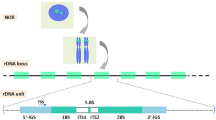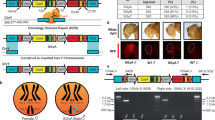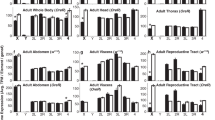Abstract
In Drosophila melanogaster, the rRNA genes (rDNA) are clustered at single sites on two non-homologous chromosomes, the X and Y. Examination of the structure of X and Y rDNAs with restriction endonucleases reveals that the X rDNA contains repeating units not present in the Y. Such obervations, as well as genetic evidence, illustrate difficulties with the hypothesis that recombination is the predominant mechanism preserving similarities between these two clusters maintained on different chromosomes. This raises the possibility that selection pressure has a significant role in maintaining the parallel evolution of these two separate but homologous redundant gene clusters.
This is a preview of subscription content, access via your institution
Access options
Subscribe to this journal
Receive 51 print issues and online access
$199.00 per year
only $3.90 per issue
Buy this article
- Purchase on SpringerLink
- Instant access to full article PDF
Prices may be subject to local taxes which are calculated during checkout
Similar content being viewed by others
References
Ritossa, F. M., Atwood, K. C., Lindsley, D. L., and Spiegelman, S., Natn. Cancer Inst. Monog., 23, 449–472 (1966).
Tartof, K. D., Science, 171, 294–297 (1971).
Maden, B. E. H., and Tartof, K., J. molec. Biol., 90, 59–64 (1974).
Morgan, T. H., Biol. Bull., 26, 195–204 (1914).
Stern, C., Genetics, 21, 625–730 (1936).
Hamkalo, B. A., Miller, O. L., and Bakken, A. H., Cold Spring Harb. Symp. quant. Biol., 38, 915–919 (1973).
Glover, D. M., White, R. L., Finnigan, D. J., and Hogness, D. S., Cell, 5, 149–157 (1975).
Southern, E. M., J. molec. Biol., 98, 503–517 (1975).
Greene, P. J., Betlach, M. C., Boyer, H. W., and Goodman, H. M., Meth. molec. Biol., 7, 87–111 (1974).
Allet, B., Jeppesen, P. G. N., Katagui, K. J., and Delius, H., Nature, 241, 120–123 (1973).
Lindsley, D. L., and Grell, E. H., Carnegie Inst. Wash. Publ., 627 (1968).
Wellauer, P. K., et al., Proc. natn Acad. Sci. U.S.A., 71, 2823–27 (1974).
Rudkin, G. T., Genetics Today, Proc. eleventh Int. Cong. Genet. 359–374 (1963).
Henderson, A. S., Warburton, D., and Atwood, K. C., Proc. natn Acad. Sci. U.S.A. 69, 3394–3398 (1972).
Evans, H. J., Buckland, R. A., and Pardue, M. L., Chromosoma (in the press).
Tartof, K. D., A. Rev. Genet., 9, 355–385 (1975).
Brown, D. D., and Sugimoto, K., J. molec. Biol., 78, 397–415 (1973).
Pardue, M. L., Brown, D. D., and Birnstiel, M. L., Chromosoma, 42, 191–203 (1973).
Author information
Authors and Affiliations
Rights and permissions
About this article
Cite this article
Tartof, K., Dawid, I. Similarities and differences in the structure of X and Y chromosome rRNA genes of Drosophila. Nature 263, 27–30 (1976). https://doi.org/10.1038/263027a0
Received:
Accepted:
Issue date:
DOI: https://doi.org/10.1038/263027a0
This article is cited by
-
Indirect evidence of alteration in the expression of the rDNA genes in interspecific hybrids betweenDrosophila melanogaster andDrosophila simulans
Molecular and General Genetics MGG (1996)
-
Increase in the resistance to the Bacillus thuringiensis supernatant effect in a Drosophila melanogaster wild type Oregon R line
Heredity (1992)
-
Localization of ribosomal DNA insertion elements in polytene chromosomes of Drosophila simulans, Drosophila mauritiana and their interspecific hybrids
Genetica (1992)
-
Studies of He-T DNA sequences in the pericentric regions of Drosophila chromosomes
Chromosoma (1989)
-
Increased number of nucleoli in the salivary gland cells of Drosophila melanogaster under conditions of rDNA dose compensation
Chromosoma (1986)



